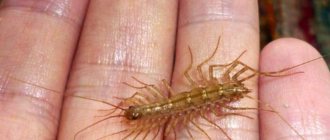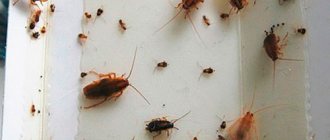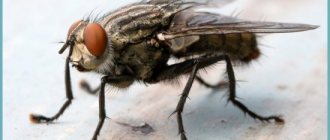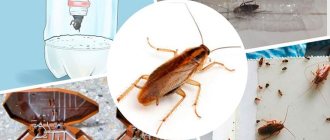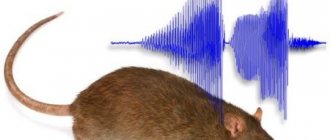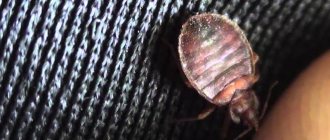The question of how to get rid of centipedes arises among those on whose territory they have settled. Centipedes are rare guests in houses and apartments; they do not cause material damage and do not threaten human health, while they destroy small pests, cleaning the area. But despite their relative safety and harmlessness, their appearance causes fear and desire to get rid of such neighbors as quickly as possible.
Centipedes are beneficial insects that destroy small pests that have settled in the house (cockroaches, flies, etc.). However, they frighten people with their appearance, which makes it necessary to look for methods of expelling them.
To combat centipedes, it is important to find out where they came from and where they live, as well as to create unfavorable conditions for their existence. Chemical preparations and folk remedies, the use of which is described in detail in the article, will help in exterminating the creatures.
Causes and dangers of centipedes appearing in homes
Centipedes are insects of the tracheal arthropod order. Their distinctive feature is a large number of long legs located along the body. The number of pairs of legs varies depending on the age of the insect, and their maximum number is 20 pairs.
There are many varieties of centipedes known, but the ones found most commonly in homes are common flycatchers. Insects have a long and thin body, divided into segments, and their color varies from gray-yellow to brown.
Less commonly, scolopendras settle in houses, which are similar in appearance to flycatchers, but have a darker color and short legs. The pest's bite is quite painful and leaves a mark similar to a burn.
Flycatchers are nocturnal insects that are afraid of light and do not come out during the daytime. At night they are very active and move quickly in search of food. At the same time, they can catch several insects at a time, using all their paws.
Centipedes live in dark and damp corners, hidden from people and light. Their usual habitat is fallen leaves, tunnels and stumps, but when the average daily temperature drops, centipedes move into residential buildings. In an apartment, they can live in the toilet, bathroom, or in the cracks between the tiles. In private homes they live in the basement or attic.
Pests are attracted to the house by warmth, dampness, darkness, and an abundance of food and water. Centipedes choose small insects as food - flies, cockroaches, mosquitoes, ants.
The main reasons for the appearance of centipedes in the house are high humidity, constant dampness and the presence of food in the form of small insects.
Why do centipedes appear?
Centipedes (or centipedes, flycatchers, fly swatters), found in comfortable apartments, usually do not exceed 2-3 cm in length. But under natural conditions, specimens of this insect grow up to 6 cm.
Flycatchers can be easily identified by the following characteristics:
- Gray-yellow body with three stripes (often purple, red or blue).
- The body consists of 15 separate segments, each of which is equipped on the sides with a pair of legs.
- The centipede's legs are shorter at the head and noticeably lengthen towards the back of the body (thanks to this herringbone structure, the insect does not get tangled in its limbs and moves at an enviable speed - up to half a meter per second).
- The insect's jaws are located not only in the mouth, but also on the front pair of legs.
- The fly swatter's head is equipped with a pair of antennae.
In the wild, centipedes live under stones, in tree roots, and under a layer of mulch in garden beds. They need a damp environment to live.
READ ALSO: Common silverfish in the bathroom: how to get rid of the small gray insect and where it comes from
Centipedes often settle in human dwellings - in damp basements of apartment buildings or private houses, on the first floors (close to the basement), in bathrooms, bathhouses. If there is a humid environment they need, in human housing the presence of other insects in the house is attractive to centipedes. After all, flycatchers are hunters. They feed on flies, midges and mosquitoes, spiders, cockroaches, woodlice, leather beetles, moths, ants and any other insects that are attracted by the warmth and availability of food in human homes.
If there are centipedes in the house, this means that the house is already infested with a large number of other insects. It was the availability of available food (along with the necessary dampness) that became the decisive factor when the centipede chose a place to settle.
The centipede is capable of simultaneously capturing up to several insects - eating one and holding others with its legs.
Which kitchen sink is best to buy? Read useful advice from experts.
Learn about the rules and methods for sterilizing screw caps for canning from this article.
Are centipedes dangerous for people?
In defense, the centipede is capable of biting a person quite strongly (its bite is comparable to that of a bee or aspen). However, this will not cause any harm to health, at most a small tumor, possibly an allergic reaction (if you have a general allergy to insect bites). The centipede will not specifically attack a person.
However, when they reproduce in large numbers, centipedes become unpleasant neighbors. They look scary and start crawling all over the house in search of food.
Creating unfavorable conditions for the existence of pests
In order to independently get rid of centipedes in an apartment, it is necessary to create conditions unsuitable for their existence. First of all, deprive them of food - destroy the insects on which they feed, and the flycatchers themselves will leave the home.
Carry out repairs - seal the cracks through which pests enter, repair pipes and sewers. Get rid of excessive dampness: check the ventilation system, install dehumidifiers and regularly ventilate the room. Centipedes are moisture-loving insects and, in the absence of sufficient humidity, will leave the house in search of more comfortable conditions.
To expel flycatchers, get rid of high humidity in your apartment or house. To this end, check the ventilation, regularly ventilate the room or install a dehumidifier
Disinsection methods for getting rid of house centipedes
It is necessary to create conditions in which they could not live.
1. Since these sponge-footed creatures do not like the smell of mastic, parquet floors treated with this product repel centipedes.
2. Effective means to combat mosquitoes and cockroaches (antiseptics, dichlorvos, crayons, gels).
3. You need to examine the surfaces in the room to seal all holes and cracks using foam, silicone or other materials.
4. Getting rid of dampness in the house is the most important task. You can use household dehumidifiers.
5
It is important to regularly ventilate all rooms in the apartment in order to reduce air humidity levels
6. The soil in pots for houseplants should be moderately moist. No need to keep water in trays.
7. There should be no wet laundry in the house.
8. Dishes in the kitchen should always be dry.
9. Entrance doors must be tightly closed.
10. Windows should be protected with mosquito nets with small holes so that centipedes cannot crawl through them.
11. To trap centipedes at night, you need to put sticky tape on the floor.
12. In places favored by centipedes, you need to sprinkle diatomaceous earth powder. This method is good in a house where there are small children, as it is completely harmless.
13
When carrying out sanitary treatment, all precautions must be taken.
Although centipedes are not as harmful creatures as other parasites, rodents, and flying insects, not all people agree to have centipedes as neighbors. Therefore, you can use effective means to destroy and repel them.
Destruction of insects by chemical means
Chemicals in the form of aerosols or sprays will help get rid of centipedes in a private home. Before using the selected product, carry out the following preparations:
- carefully read the instructions and rules for using the drug;
- take the recommended safety measures - wear gloves, a protective suit, a respirator;
- make sure that there are no children or pets in the room during processing;
- hide all food supplies and take indoor plants to another room;
- After using the drug, close the room and leave it for several hours, and then ventilate the apartment well and carry out wet cleaning.
Centipedes are insect predators that feed on other pests, so poison in the form of bait may be useless and ineffective.
Popular means of combating centipedes are presented in the table:
| Name | Mode of application | Features of use |
| Aquafumigator "Raptor" | Install the device indoors and plug it into the network. As the water and toxic substance evaporate, the room is enveloped in steam that kills insects | The product is effective in the fight against centipedes, cockroaches, flies and other pests. Remove people and pets from the room before using the device. |
| Aerosol Henkel Combat | Spray the aerosol into cracks, under baseboards, between pipes and other potentially dangerous areas | The product has a pungent odor, so you should only work with it wearing a respirator. |
| Suspension "Lambda Zone" | Treat the areas where insects have been spotted with your chosen product. | The drug is effective against insects, while being safe for people and animals |
| Gel GLOBOL | Dissolve the drug in water according to the instructions and pour into a container with a spray bottle. Spray the solution on baseboards, cracks, pipes and other places where pests accumulate. | The product does not have a sharp or unpleasant odor |
| Aerosol Raid | Spray the product in pest habitats | Safe for home residents, no pungent odor |
| Aerosol “Dichlofos Heo” | The effect lasts for a month | |
| Con | Prepare the solution according to the instructions and spray it on the areas where the centipedes were marked. | When working with the drug, use gloves, a mask or a respirator. |
Fighting a centipede
We have already figured out the reasons for the appearance of uninvited guests in the house, now we will tell you how to get centipedes out of the apartment. Flycatchers are fairly fast creatures, so it is unlikely that you will be able to catch them. It is necessary to ensure that the conditions in the apartment are unfavorable for the arthropod. The following recommendations must be followed:
Get rid of excess moisture in the apartment. Ventilate the room, wipe the floor in the bathroom, and in the kitchen empty the water from the trays in the dish drainer. Get rid of indoor insects that are food for the centipede. Go through your stocks of potatoes and vegetables, getting rid of rotten products. This will prevent fruit flies and other pests from breeding. Check the condition of kitchen cabinets where food and utensils are stored. Carry out regular wet cleaning of the premises by adding a little soda to the water and treating the possible habitats of arthropods with the solution.
Pay due attention to baseboards and crevices. In the bathroom, you can treat the floor around the perimeter and the exit points of water and sewer pipes with silicone. Close the front door and put a mosquito net on the windows.
Use of chemicals
If a house centipede has already settled in your apartment, preventive measures will no longer be effective. You need to know how to get rid of centipedes in your home using chemicals. You can use the same means as in the fight against cockroaches:
- Boric acid in dissolved form. You can simply pour it on the floor in several places and wait until the pest is poisoned and dies.
- Crayons and insecticidal gels. It is better to apply them to the walls and leave them for a week. After the death of all individuals, the products can be washed off.
- Insecticidal sprays and aerosols. This is an extremely effective and fast method of controlling arthropods. However, you need to be very careful when spraying the product. For several hours after treatment, people and pets should not be allowed in the house. After this, it is necessary to carry out wet cleaning and ventilation of the room.
Food grade diatom powder. This is one of the safest means of combating arthropods, as it is not toxic to humans. The powder can simply be sprinkled on the floor behind furniture and near baseboards. After a few days it can be removed with a vacuum cleaner.
How to get rid of centipedes using traditional methods
Folk remedies will help get rid of several individuals in the apartment. Despite the simplicity and availability of available methods, when using them, exercise caution and safety measures. Improper behavior with household poisonous compounds can lead to intoxication.
Cayenne pepper will help remove flycatchers, the aroma of which is not tolerated by pests. Sprinkle the powdered product where insects appear and they will soon leave the house
Boric acid is used to control pests. Sprinkle it under baseboards, in bathrooms behind pipes, and in other centipede habitats. The product is effective in combating many insects, while being safe for people and animals.
Diatomaceous earth powder will help remove pests. This is a safe, non-toxic product with no pungent odor. To kill pests, simply sprinkle the powder in their habitats and they will soon leave your home.
Origin of the species and description
Centipedes are classified as centipedes from the subclass of invertebrates, which unite four classes of terrestrial arthropods. There are more than 12,000 species of centipedes, including 11 fossils that lived about 450 million years ago. The clearly identified fossils date back to the late Silurian period and are considered to be the oldest arthropods to emerge from the ocean onto land to date.
Video: Centipede
Due to the similar structure of the limbs and a number of other characteristics, for quite a long time centipedes were classified as insects, but they are not. After much research, it was found that centipedes represent a sister group to ordinary insects, that is, they have a common ancient ancestor, but all kinship ends there. This species of arthropod formed a superclass of the same name - millipedes, which belongs to the subphylum tracheae.
Fun fact: Adult centipedes can have anywhere from 30 to 354 legs, but the number of pairs of legs is never even. The house centipede, or common flycatcher, as it is also called, has legs that grow gradually as the individual grows older, and as a result, mature centipedes have 15 pairs of limbs. If a flycatcher has fewer than 30 legs, it has not yet reached sexual maturity.
Preventing pests in the home
To prevent the appearance of centipedes in an apartment or private house, take the following preventive measures:
- destroy insects that are food for centipedes - cockroaches, flies, ants;
- seal the cracks through which pests can enter the house, and install mosquito nets on the windows;
- dry the room, adjust the ventilation system, get rid of sources of high humidity. If necessary, purchase and install dehumidifiers;
- regularly carry out general cleaning and ventilate the room;
- check the condition of attics and basements in private homes.
To avoid the appearance of centipedes, create the most unfavorable conditions for them in the house - destroy insects, regularly clean and maintain optimal humidity
You can fight centipedes yourself by creating unfavorable conditions for their existence or using chemicals. To avoid having to deal with pests in your home again, follow preventive measures, maintain cleanliness and an optimal level of humidity in the room.
How to recognize a centipede?
The centipede (also known as flytrap, centipede, centipede) belongs to the class of tracheal arthropods with a respiratory system. Thanks to the latter, flycatchers are able to exist on land, although they vitally need a humid environment.
This insect is ancient. It came to us from those times when the world did not yet know ape-like creatures. The scolopendra's body is flattened and divided into 15 segments. The limbs are located on the sides (15 – 40 pairs). If damaged or lost, each is capable of growing back. The first pair has pincers designed to capture the intended victim and immobilize it by injecting paralytic poison. The bite is not dangerous to humans, although it causes pain. The poison is harmful only to insects - flies, snails, slugs, cockroaches. Excellent vision helps her see clearly during the day as well as at night. Can reach movement speeds of up to 40 cm per second. Thanks to its flat body, the flycatcher is able to crawl into the narrowest crevices. A pair of antennae are landmark antennas in space.
Is the centipede dangerous for humans?
If a centipede in an apartment feels threatened, it may attack and bite. However, it is not able to bite through human skin. There may be redness and slight swelling at the site of the bite.
Unlike this species, the ringed or Crimean scolopendra bites more noticeably. Some people compare the feeling to being stung by a bee multiple times. Its poison is not life-threatening unless the victim is allergic.
Centipedes hide not only in cracks or under furniture, but also in shoes. To avoid being bitten, you need to check it before you put it on.
Remove the centipede's food source
Centipedes will not take up residence in a home unless there is a food source there. Therefore, your home should be checked for the presence of insects. As a rule, most centipedes will leave on their own after destroying spiders, cockroaches, flies and other living creatures. To do this, you can use various chemicals. But you shouldn’t hope that they will kill the flycatchers either. These creatures quickly develop immunity to insecticides and adapt to new conditions. Other methods will help you get rid of them completely.
Benefits and harms
Most owners believe that this terrifying-looking arthropod must be destroyed. Many people do not know that the flycatcher is beneficial: it eats flies, ants, cockroaches, and other harmful insects that live in a person’s home.
The centipede does not touch supplies in the kitchen in the house, does not carry diseases, and does not damage furniture. The only unpleasant moment is the unattractive appearance. A creature with numerous legs that suddenly appears on a wall or floor frightens even people with strong nerves.
Does this strange creature pose a danger to humans? Pest control specialists and doctors do not consider the arthropod an enemy: the bite is not dangerous, the centipede attacks only in defense. Fear due to the terrible appearance of an arthropod is all the unpleasant consequences that await a person after “acquaintance” with a flycatcher.
